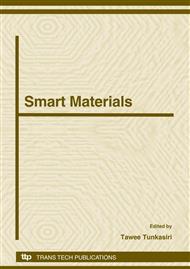p.529
p.533
p.537
p.541
p.545
p.549
p.553
p.557
p.561
Attachment of Metal Oxide Nanoparticles on Carbon Nanotubes with Different Oxidation Levels
Abstract:
An efficient surface modification technique for fabricating tin dioxide/carbon composite nanotubes has been developed. This technique combines with implantation of acidic groups, interaction between surface oxides and metal ions or hydration molecules, and thermal. To functionalize multi-layered carbon nanotubes (CNTs), gaseous oxidation at 300°C was used to build functional oxygen groups including carboxyl, carbonyl and hydroxyl group, on ends or sidewalls of CNTs. X-ray photoelectron spectroscopy clearly indicated that the atomic ratio of attached tin-oxide on the oxidized CNTs gradually increases with the oxidation level, i.e., surface O/C atomic ratio. This evidence reflected that the surface oxides act as an adsorption center that strongly interacts with metal ions or hydration molecules in aqueous phase.
Info:
Periodical:
Pages:
545-548
Citation:
Online since:
August 2008
Authors:
Price:
Сopyright:
© 2008 Trans Tech Publications Ltd. All Rights Reserved
Share:
Citation:


